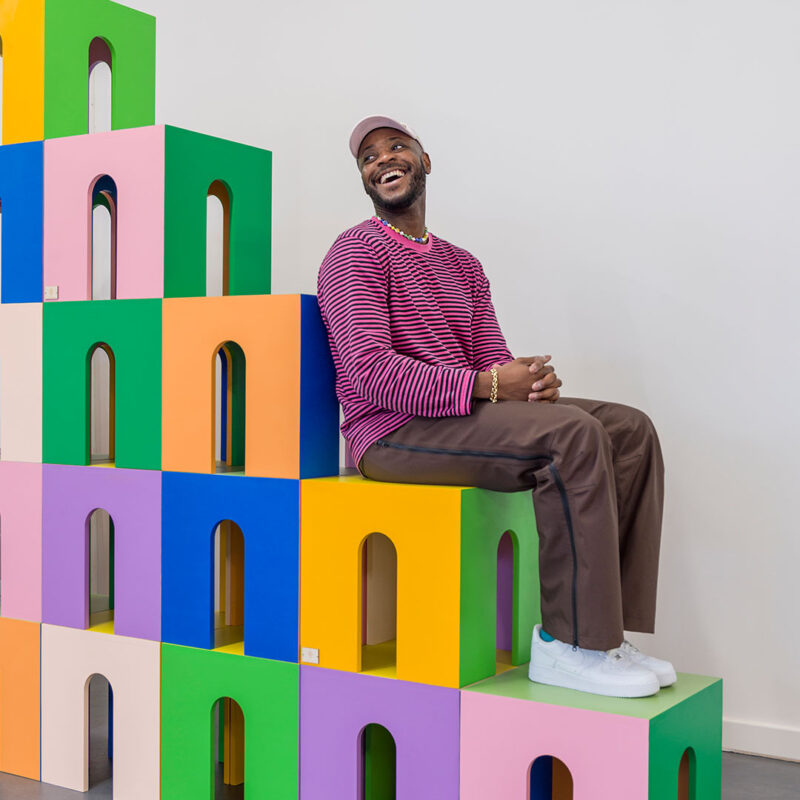
co-living - building communities
Written By
The Davidson Prize
05.05.2022
Multi-disciplinary artist and designer Yinka Ilori chats to The Davidson Prize about why co-living hits home to him and judging the 2022 Prize
Have you ever wanted to live in a commune?
I would love to! My parents lived in a village in Nigeria that bears many similarities to a commune, so I’ve seen first-hand how beneficial that way of life can be. What probably draws me to it most is that you have a sense of belonging to something.
What are your own experiences of shared living and how have they influenced you?
I grew up on a council estate in North London made up of a block of 50 flats, where I lived with my parents, brothers and sister surrounded by other families. What was notable about this living environment was that it meant we were incredibly invested in each other’s lives. The community was a huge part of my upbringing; we habitually came together with our neighbours to share food, play together and use what we had at our disposal to be creative and keep dreaming up ideas.
We had a small balcony where I would run up and down with other kids from the estate, pretending it was a running track in the Olympics. We made use of what was there, no matter how ordinary and everyday, to create memories together. It was an incredible experience to live with a wider sense of family and we built relationships that endure to this day.
Growing up in that environment also shaped the way I view and use space in my work. I would say I have highly developed understanding of the nuances around the division of public or communal space and private space, and it’s these ideas that I use in my work and in my living and studio environment. I really believe in what well thought-out space can do for communities, and I apply this to create work that ignites and livens-up environments to bring people together with a sense of intrigue and shared exploration.
Is it demand or supply that’s holding back the development of alternative models of living?
I’d say many of the ‘adult dorm’ style co-living spaces popping up recently in cities like London, New York and Paris don’t fully explore what could be achieved. They are managed by third-party providers and are often expensive, have a lower standard of quality and don’t necessarily aim to serve a community in any real way. I think this has made consumers cautious. I also think developers are hampered by the lack of land available to be innovative and create a profit while still serving residents in a real way.
On the flip side there’s certainly lot of demand. I’m thinking about young people who may have recently moved to a big city, single parents or recent immigrants looking for alternative residential models. We currently have a housing shortage, with sky-rocketing prices and a lot of young people unable to access affordable housing. I think co-living is going to be considered much more seriously in future, that experimentation will be encouraged as a way of combatting loneliness and helping create stronger communities as well as helping tackle climate crisis.
Where do you see the future of architectural communications heading?
Communication is increasingly recognised as a key skill in design, crucial to creating effective conversation around some of the big challenges facing urban environments today. New visualisation technologies including VR and AR enable architects to explain complex ideas to local government and planners but more importantly to communities. Effective design communication is about really engaging local residents and families in the ideas and proposed solutions that will shape their neighbourhoods, schools and places of work.
What have you looked for as a judge of the 2022 Davidson Prize?
Apart from beautiful design, I would say simple but innovative ways of using space to build real communities, encourage collaboration and explore ideas of togetherness and reducing carbon footprint.
What I would really like to see in a co-living space is architects and designers creating opportunities for residents. I’m particularly excited by the potential to provide ecosystems for play and collaboration – whether that’s spaces that encourage the sharing of ideas, tools that encourage skills development, open green spaces where people can grow food together and connect with nature, or anything that sparks imaginations and allows residents to create memories and share like a family.